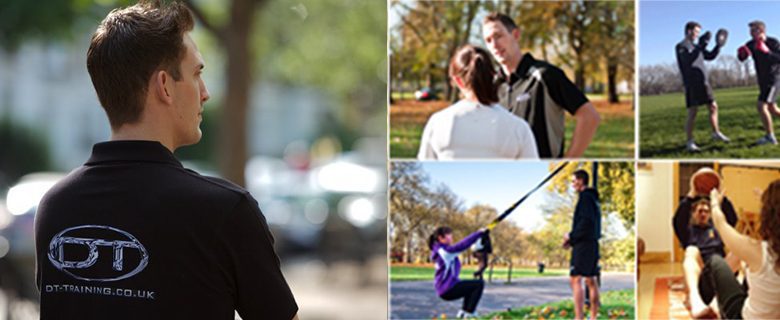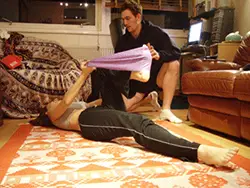
Top tips for getting fit if you’re disabled
Want to get fit but assume using a personal trainer would be out because of your disability? We talk to Dom Thorpe, a personal trainer specialising in helping people with all kinds of disabilities get fit. Read on to see how you can get fit too…
Please can you tell DH readers a bit about yourself and your company?
 I’m Dom Thorpe, the Managing Director of DT Training. 10 years ago I was managing a gym, but I soon realised that sitting at a desk in the back office all day didn’t appeal to me, so I wanted to do a role that had more face-to-face contact with customers. I decided to set up my first personal training company, DT Training, as I had seen a former colleague do the same thing and he now has around 20 trainers working for him. I thought that if he could do it, so could I.
I’m Dom Thorpe, the Managing Director of DT Training. 10 years ago I was managing a gym, but I soon realised that sitting at a desk in the back office all day didn’t appeal to me, so I wanted to do a role that had more face-to-face contact with customers. I decided to set up my first personal training company, DT Training, as I had seen a former colleague do the same thing and he now has around 20 trainers working for him. I thought that if he could do it, so could I.
I chose to specialise in training people with disabilities. At the time my Mum had multiple Sclerosis and I could really see the way that physical training could benefit her.
You’ve specialised in teaching people with disabilities, can you tell us more about this?
I investigated the various qualifications needed for training specifically with various disabilities (there wasn’t much out there) and managed to find a couple of courses that taught me to use my existing knowledge of fitness, but to modify the methods in order to make them suitable for people with all different kinds of disabilities.
The first was with the YMCA and was called Level 3 Exercise for Training with Disabilities. The second was through the Wright Foundation and was called Exercise Referral. This was more for clients who had been referred by their doctors to do exercise. It really taught me about the effects of various medications on peoples’ ability to carry out exercise, as well as the dos and don’ts around these particular medications.
On top of this I had previously done an in-house course named Welcoming People with Disabilities, which was aimed at teaching us a common sense approach to making people with disabilities feel welcome and to avoid alienation or being patronising.
 What things do you need to consider when training someone with a disability?
What things do you need to consider when training someone with a disability?
When training someone with a disability you really need to think outside of the box. The same fitness principles apply, but you can’t just dish out the usual tricks. An obvious example is the fact that a wheelchair user can’t simply go for a run, and many people think that running is the only form of cardiovascular exercise out there. In these cases, it’s about working out ways to raise the heart rate without using the legs. Often a simple circuit switching between abdominal exercises and upper body exercises can achieve the same result.
Sometimes it’s about taking a step back and working on simple movements, such as standing up from a seated position. For those with a weak lower body this is a great exercise and, when done in the right quantity, can work on both strength and cardiovascular aspects of fitness.
In many cases, fitness training is simply about showing people that they CAN do exercise despite their disability. The first thing I try to do when meeting someone is focus on what they CAN do, not what they can’t do.
What advice do you have for disabled people who wish to be fit and healthy, but don’t know where to go or where to start?
 For disabled people who wish to get fit and healthy, the biggest thing to remember is that there’s always something you can do. Whether it be related to exercise or related to diet and lifestyle. You just need to follow the basic principles of health and fitness and make them work for you.
For disabled people who wish to get fit and healthy, the biggest thing to remember is that there’s always something you can do. Whether it be related to exercise or related to diet and lifestyle. You just need to follow the basic principles of health and fitness and make them work for you.
And if you’re really stuck, look for local classes for people with similar conditions, or try to locate a suitably qualified personal trainer.
What are your top exercise tips for disabled people?
- Cardio doesn’t mean just running! Anything which gets your heart rate up is a cardiovascular exercise. It can be done with weights, arms, abs,
legs or a combination of all of those. It just needs to be consistent or repetitive. The higher the heart rate, the more fuel you will burn. - Focus on strength exercises 50% of the time and cardio 50%. Often people either focus on purely cardiovascular fitness such as running, handbike etc, or the other extreme and just do weight training without a cardiovascular aspect. Your health will benefit more if you do both strength and cardio. Cardio keeps you alive and healthy, limiting
the risk of cardiovascular disease. Strength keeps you strong, functional and helps prevent weight gain and boosts your immune system. - Remember the fundamental rules – and the same rules of health and fitness apply to both disabled people and non-disabled people. These are:
a) For weight loss, burn more fuel than you consume and vice-versa for weight gain.
b) For strength gains lift more weight than you are used to lifting.
c) For endurance perform an activity for longer than you are used to doing.
d) In every case, you must progress. Doing the same thing repeatedly won’t result in any increase of fitness. Go longer, lift more, move faster train more frequently.
As the majority of clients who I deal with experience difficulty standing or using their lower body parts, I have created a catalogue of exercises which can be done without standing. Perform them in sequence, with little or no break, and you’ll have a good workout, which will develop both strength and cardiovascular fitness. Here’s an example of a couple of my videos:
What are your top 5 tips for keeping fit and healthy?
The right diet! If you have excess body fat it’s because you’re eating/drinking more than you need or you have done in the past. Diet is for weight control, exercise is for fitness.
- Book regular exercise sessions into your diary. It’s far more likely that you will be consistent this way.
- Carry out a varied workout. Weights and strength should make up as much if not more of your regime than cardio.
- Be consistent. Exercise is a way of life. It’s not something you pick up and put down when you’re feeling in or out of shape.
- Find someone to train with. Whether it’s a friend, family member, work colleague or a personal trainer. You’re far more likely to succeed if you have a companion.
If anyone would like to sign up to use your services, how can they get involved?
If anyone is looking to get fit with me they just need to get in touch via email or phone – dom@dt-training.co.uk or 07972 672 379 and we can look to book in a free taster session to discover what we can do to help them achieve their goals.
You can visit Dom’s YouTube channel to see the full series of his videos.
By Zubee
Check out…
• Q&A with Ashley Thomson: one-handed hairdresser
• Q&A with Jack Eyers
• Q&A with disabled skier Talan Skeels-Piggins
Get in touch by messaging us on Facebook, tweeting us @DHorizons, emailing us at editor@disabilityhorizons.com or leaving your comments below.
